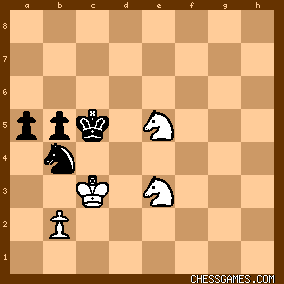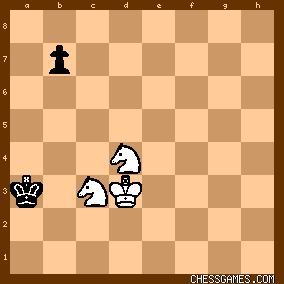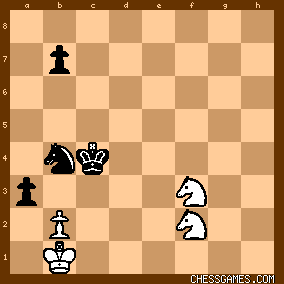|
< Earlier Kibitzing · PAGE 2 OF 2 ·
Later Kibitzing> |
| Apr-06-15 | | Howard: If Geller had been in time trouble, then perhaps Spassky would have played on for awhile. But to bother resuming an adjourned position such as this one...it would have been an easy win for Geller, especially with the benefit of overnight analysis. Granted, on the next move Black can snip off the a-pawn, but one remaining pawn would have been enough for Geller to win. The key to winning would have been zugzwang. Sooner or later, Spassky would have run out of moves and been forced to make concessions. With Geller's extra knight though, he would not have had to worry about that. |
|
| Apr-06-15 | | zydeco: It looks like this was Geller's only win against Spassky for the ten-year stretch between 1964 and 1974. (Spassky had a clean sweep of Geller in their two Candidates matches.) I guess 21....Bxh3+ is overly optimistic; and 27....Rd8 is a mistake. Spassky must have missed 29.Be4! |
|
| Mar-19-18 | | edubueno: Me parece que B.S. no quiso analizar demasiado. Creo que la posición es de tablas. |
|
| Sep-10-18 | | edubueno: En la jugada 27...Td8?? es un grave error porque la torre negra queda encerrada. Las negras, que tenían mejor posición, la arruinaron en una sola jugada.
27...g6 28.Kg3 Re6 29.Nd4 Ree8 30.Be4 Rbd8 31.Nxc6 bxc6 32.Ra5 Rd4 33.Bxc6 Re6 34.Bd5 Re7 35.Bc6 Kg7 36.Rd5 Rxd5 37.Bxd5 Re5 38.Kh4 deja una posición pareja con las negras bien situadas. |
|
Jun-30-20
 | | Honza Cervenka: 41.Nxh4 makes no sense, as after 41...Nxa2 the ending is quite obvious draw. I guess that 41.a3 with next 42.Nxh4 was the finish of this game. |
|
| Jun-30-20 | | Atking: That surely not an easy ending to win even after 41.a3 h3 with Troisky "M" in mind. For if 42.axN+ Kxb4 43.Kd3 Kb3 44.Nd1 a5 45.Nd4+ Kb4 46.Nf2 h2 47.Kc2 a4 48.Kb1 Kc4 49.Nc2 Kb3 50.Ne3 a3 is going to be draw. White could surely improve somewhere but it seems clearly to soon to resign here. |
|
Jun-30-20
 | | beatgiant: <Honza Cervenka>
I'm not actually seeing the <quite obvious draw> after 41...Nxa2. For example, 41...Nxa2 42. Kd3 Nb4+ 43. Kc3, and now the knight trade with 43...Nd5+ 44. Nxd5 Kxd5 is a tablebase win for White, or 43...a5 44. Nf3 b5 45. Ne5. 
click for larger viewNow knight trades wiith 45...Nd5+ or 45...Nc6 still give tablebase wins for White, 45...a4 46. Nd7+ wins, and other lines seem to allow White to gradually push Black back. It might still be a draw, but certainly not obvious to me. Could you post what you found that made it look obvious to you? |
|
| Jun-30-20 | | Retireborn: 41.Nxh4 was a sealed move, according to Geller's book, I think. <Honza> is correct to say that 41.a3 is stronger, though. In <Atking>'s line replace 50.Ne3 with 50.Na1+ Kb4 51.Ka2 b5 52.Nc2+ Kc4 53.Ka3 Kc5 54.Ne3 Kd4 55.Neg4 & 56.Nxh2. It's interesting how the knights coordinate to stop the black king approaching the h-pawn. |
|
Jul-01-20
 | | beatgiant: <Retireborn>
But in that line what if Black jettisons the h-pawn to rush to trade off White's last pawn, as in:41. a3 h3 42. axb4+ Kxb4 43. Kd3 Kb3 44. Nd1 <h2> 45. Nxh2 a5 46. Nf3 a4 47. Nd4+ Kb4 48. Nc3 a3 49. bxa3+ Kxa3 
click for larger viewTablebase here shows 51. Ndb5+ as "win in 53," but we'd need to know whether that includes any Black pawn move to satisfy the 50-move rule. Of course, you still might find improvements for White here, but my main point is that none of this seems obvious to me, especially when making a crucial sealed move before an adjournment. |
|
| Jul-01-20 | | Retireborn: <beatgiant> In your line White should play 49.Nc2+, I think. Yes, the win isn't obvious but probably Spassky just assumed a piece down was losing. Geller may have been more aware of the problems, but didn't address them in his book. |
|
Jul-01-20
 | | beatgiant: <Retireborn>
You are correct, I missed 49. Nc2+. This Nc2+ resource also kills another Black try with 41. a3 h3 42. axb4+ Kxb4 43. Kd3 Kb3 44. Nd1 a5 45. Nd4+ Kb4 46. Nf2 a4 47. Nxh3 a3 <48. Nc2+>, so I learned something!Having seen all that, I have to agree that yes, 41. a3 h3 42. axb4+ looks like a proven win, while 41. Nxh4 Nxa2 is still unclear, although I haven't yet managed to find a draw, let alone an obvious one. I really doubt <Spassky just assumed a piece down was losing> and resigned there, especially when an adjournment gave time to analyze it. Maybe <Honza>'s original theory was right, and the game continued 41. a3 Nc6 42. Nxh4 instead? Both of these players could have seen that 41. a3 <h3> does not quite work. |
|
Jul-01-20
 | | Honza Cervenka: Well, I played as black from final position against Houdini and got a tablebase draw after 41...Nxa2 42. Kd3 a5 43. Nf3 a4 44. Ng5 b5 45. Ne4+ Kb4 46. Kc2 a3 47. Kb1 axb2 48. Kxa2 b1=Q+ 49.Kxb1 Ka5 etc. |
|
Jul-01-20
 | | Honza Cervenka: But I see now that instead of 47.Kb1 white can play much better 47.b3, so I have to be more careful here. |
|
| Jul-01-20 | | Atking: <beatgiant: <Retireborn>
But in that line what if Black jettisons the h-pawn to rush to trade off White's last pawn, as in: 41. a3 h3 42. axb4+ Kxb4 43. Kd3 Kb3 44. Nd1 <h2> 45. Nxh2 a5 46. Nf3 a4 47. Nd4+ Kb4 48. Nc3 a3 49. bxa3+ Kxa3> Thanks to all of you for testing the position which was indeed not an easy one. Yes <h2> improve Black chance to draw. 1-0 in 53 moves you said. Quite a lot Just curious to know if at time 50 moves rules was in application? (Yet in our actual case it doesn't work as the pawn should have to move toward the end.) In your diagram <beatgiant> Black to play and Troisky will say it's a draw (I should test it with a comp but I'm pretty sure that it's a draw.) One tempo affair indeed. I use to appreciate <Honza Cervenka> your chess comments Right now I will appreciate also your humility. Great to have so mutch Chess lovers in this site! |
|
Jul-01-20
 | | Honza Cervenka: Well, what about this?
41...Nxa2 42. Kd3 a5 43. Nf3 a4 44. Ng5 b5 45. Ne4+ Kb4 46. Kc2 Ka5 47. Nc5 Nb4+ 48. Kc3 Na2+ 49. Kd4 Nb4 50. Ke5 Nc6+ 51. Kd6 Nd4 52. Kd5 Nf3 53. Nc2 Nd2 54. Kd4 Nc4 55. Kc3 Nxb2 56. Kxb2 and it's tablebase draw. |
|
Jul-01-20
 | | beatgiant: <Honza Cervenka>
My gut feeling is, strategically, White's king should not wander away from the main battle front with moves in your line like 48. Kc3, 49. Kd4, 50. Ke5, 51. Kd6. What motivates that plan? My analysis above assumes White will keep his king near the pawns and gradually push Black back. But I will post a more detailed response if time permits. |
|
| Jul-01-20 | | Atking: <Honza Cervenka> Sure the line starting with 41...Nxa2 42.Kd3 a5 43.Nf3 a4 then 44...b5 (on purpose to kill the last pawn) seems to me too a realistic try for a draw. The question is more and less about 41.a3 h3 could it be draw (I doubt of that but the win is surely not an easy task)? |
|
Jul-01-20
 | | beatgiant: <Atking>
If 41. Nxh4 is a safe win for White, then Geller definitely would not want to seal 41. a3 and guarantee that he will face 41...h3 the next morning after Spassky has had time to study all possible traps and maybe even discover a miracle save. So it really is important to establish whether 41. Nxh4 Nxa2 gives any real drawing chances. I'm not convinced yet, for reasons I have posted above. |
|
| Jul-01-20 | | Atking: Ok waiting for new ideas! <beatgiant> |
|
Jul-02-20
 | | Honza Cervenka: Btw, 41...Nxa2 42. Kd3 a5 43. Nf3 a4 44. Ng5 b5 45. Ne4+ Kb4 46. Kc2 Ka5 47. Nd5 Nb4+ 48.Nxb4 Kxb4 is tablebase draw too. |
|
Jul-02-20
 | | Honza Cervenka: The main problem of white is that he cannot just sit and wait, if he wants to try to win this ending after 41.Nxh4 Nxa2. And black must just annihilate the last Pawn of white and avoid any situation where white gets K+2N vs K+P(s) and is still able to force the mate, which is not so difficult task, if black Pawns are a+b. |
|
Jul-02-20
 | | Honza Cervenka: <Atking: That surely not an easy ending to win even after 41.a3 h3 with Troisky "M" in mind. For if 42.axN+ Kxb4 43.Kd3 Kb3 44.Nd1 a5 45.Nd4+ Kb4 46.Nf2 h2 47.Kc2 a4 48.Kb1 Kc4 49.Nc2 Kb3 50.Ne3 a3 is going to be draw.> 50.Na3 Kb4 51.Ka2 Kc5 52.Nc2 with next Ka3 looks better here. |
|
Jul-03-20
 | | beatgiant: I looked at it myself as much as time permits, and concluded that <Honza Cervenka> is probably right. With careful play 41. Nxh4 Nxa2 looks drawish. I could post some lines, but it's nothing new or surprising. Usually Black rushes to play ...Kb4, ...a5, ...a4, ...a3, and if White has his king on c2 and replies with b3, then Black keeps pushing the a-pawn, forcing its trade for White's b-pawn. Sometimes Black sacrifices a knight to accomplish this, landing in a drawn 2N vs P ending. I didn't find a convincing way for White to prevent this plan. So while sealing a move, it would be worth it to spend enough time calculate out the 41. a3 h3 line, since that does look like a definite win for White. This validates <Honza>'s earlier remark, the finish here is strange. With all those drawing chances remaining, it would not be normal to resign an adjourned game after 41. Nxh4 Nxa2. |
|
Jul-03-20
 | | beatgiant: I'll post just one example line with some light comments to show some of Black's resources here. 41. Nxh4 Nxa2 42. Kd3 a5 43. Kc2 Kb4
44. Nd1 (or 44. Kb1 <Nc3+> works) Kc4 45. Nf2 (otherwise Black threatened ...Nb4+, ...Nd3, ...Nxb2) a4 46. Nf3 Nb4+
47. Kb1
Here White has a trap to foil 48...Kb3?? 49. Nd2#, but Black pulls out a typical resource. <48...a3>

click for larger viewNow if 49. bxa3 <Kb3>, or 49. Nd2+ Kb5 50. bxa3 Ka4 51. Kb2 <Nc2>, or 49. Nd2+ Kb5 50. b3 Nc6, planning 51...Nd4, 52...Nxb3 all see Black offering a knight to trade down to a drawn 2N vs P ending. |
|
| Jul-03-20 | | Atking: Yes <beatgiant> this line 41.Nxh4 is probably draw... Thanks for the try. <Honza Cervenka> yes <Retireborn> did a similar improvement on Jun 30. My point was mainly <It 's not an obvious win>(Indeed for me). |
|
 |
|
< Earlier Kibitzing · PAGE 2 OF 2 ·
Later Kibitzing> |





































